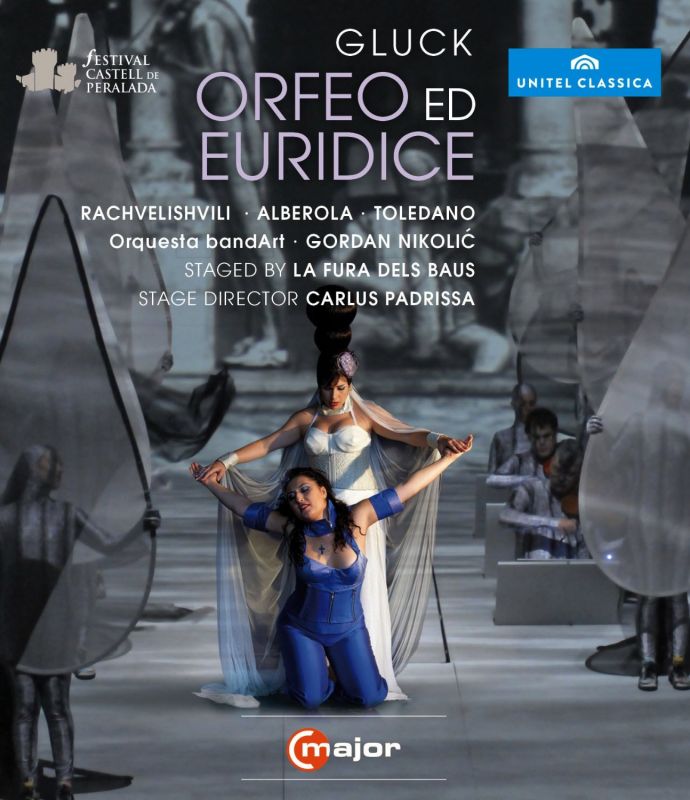GLUCK Orfeo ed Euridice
Gluck’s Orfeo gets La Fura dels Baus treatment
View record and artist detailsRecord and Artist Details
Composer or Director: Christoph Gluck
Genre:
Opera
Label: C Major
Magazine Review Date: 11/2012
Media Format: Digital Versatile Disc
Media Runtime: 110
Mastering:
Stereo
DDD
Catalogue Number: 710308

Tracks:
| Composition | Artist Credit |
|---|---|
| Orfeo ed Euridice |
Christoph Gluck, Composer
Anita Rachvelishvili, Orfeo, Mezzo soprano Auxiliadora Toledano, Amore, Soprano Christoph Gluck, Composer Gordan Nikolic, Conductor Maite Alberola, Euridice, Soprano Orchestra bandArt Palau de la Música Catalana Chamber Choir |
Author: David Patrick Stearns
While Wilson’s hallmark is spare, meticulously composed stage pictures, the Fura dels Baus stage director Carlus Padrissa keeps the stage in a constant state of motion, often in ways that are conceptually rooted in historic authenticity. The theory that 18th-century opera wasn’t considered static because of the subliminal effect of flickering, pre-electric footlights is updated here with a use of projections that, content aside, keep the stage pulsating during the music’s extensive ruminative passages. The opera’s 1762 Vienna version also feels better integrated theatrically here, partly because the production doesn’t periodically break into choreography. Designated balletic moments are ones where the production’s already-established visual language progresses to a new level of intensity.
Each section has its own colour palette. Orpheus’s First-Act lamentations are seen in a blue/grey dusk amid neo-classical façades and a clouded sky that’s constantly in motion. Figures onstage walk behind large, tear-shaped screens that give an extra refraction effect to the projections at hand. Naturally, Orpheus’s descent into the Underworld is full of red flames, while the blissful Elysian Fields at first look like a white marsh, eventually progressing into a difficult-to-describe otherworldly effect characterising the spirits there as white, elongated beings reaching upward, with arms wafting in the wind like tentacles, but also casting long white shadows. At various points in the opera the sky is full of musical notes, often in archaic notation.
At times, one becomes visually lost – in a good way. The production’s visual density combined with purely video effects sometimes converges into moments when you don’t know whether images are real people or projections. Amore is seen simultaneously in two different manifestations – in a long shot showing her silhouette in a flowing golden gown and in a close-up showing her benevolent singing face. The total effect is often similar to Peter Greenaway films at their most fantastical (such as Prospero’s Books). Of course, one is bound to disagree with at least some of the visual decisions. As Eurydice, Maite Alberola looked rather tarted up for having been dead. Also, I wondered why there was no attempt to make Anita Rachvelishvili’s Orpheus look more male.
The big surprise is that, no matter how busy the screen becomes, it rarely distracts from the music – though the excellent cast must be forgiven for seeming a tad distracted by so much visual stimulation swirling around them. Nevertheless, Rachvelishvili is a vocally robust, poetically alert Orpheus, though Auxiliadora Toledano steals the vocal honours in her wonderful portrayal of Amore. Orquesta bandArt is onstage, costumed in lizard-like body stockings, sometimes participating in the action, first as part of Eurydice’s Act 1 funeral procession and later as the aggressive underworld Furies. Though the playing is generally good, one feels the lack of a strong central musical vision. Dance rhythms sometimes feel clunky. The inventive continuo player is often too loud. Minor complaints, these.
Discover the world's largest classical music catalogue with Presto Music.

Gramophone Digital Club
- Digital Edition
- Digital Archive
- Reviews Database
- Full website access
From £8.75 / month
Subscribe
Gramophone Full Club
- Print Edition
- Digital Edition
- Digital Archive
- Reviews Database
- Full website access
From £11.00 / month
Subscribe
If you are a library, university or other organisation that would be interested in an institutional subscription to Gramophone please click here for further information.




